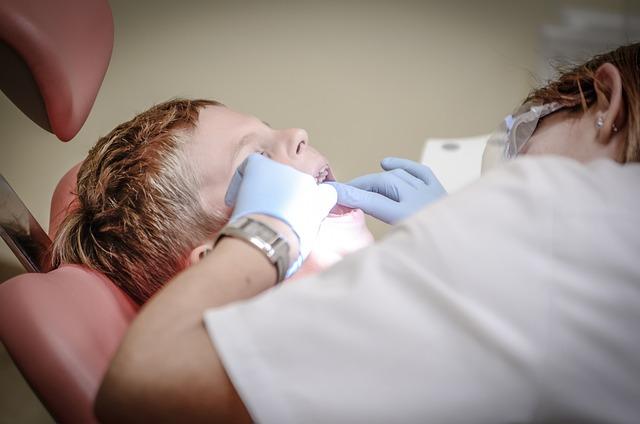How to Make Salt Water Rinse for Tooth Extraction: Guide
Are you scheduled for a tooth extraction and looking for a simple yet effective way to promote healing and prevent infection? Look no further! In this comprehensive guide, we will walk you through the step-by-step process of making a salt water rinse, a tried-and-tested solution for maintaining oral hygiene after tooth extraction. With our easy-to-follow instructions and expert advice, you’ll be equipped with the knowledge to create a homemade rinse that will aid in your recovery process. So, let’s dive in and learn how to make a salt water rinse that will leave you feeling confident and well-informed for your upcoming tooth extraction!
1. Understanding the Importance of Salt Water Rinse in Tooth Extraction Recovery
After undergoing a tooth extraction, it is crucial to understand the significance of a salt water rinse in the recovery process. This simple yet effective technique can greatly aid in promoting healing, reducing discomfort, and preventing complications. Let’s delve into why incorporating a salt water rinse into your post-extraction routine is paramount.
Benefits of a salt water rinse in tooth extraction recovery:
- Promotes healing: Salt water acts as a natural disinfectant, helping to keep the extraction site clean and free from bacteria. This aids in preventing infection and promotes faster healing.
- Reduces discomfort: Salt water rinses have a soothing effect on the gums and can alleviate pain and swelling associated with tooth extraction. It provides a gentle and refreshing sensation, providing relief during the recovery period.
- Prevents dry socket: Dry socket is a common complication after tooth extraction, which occurs when the blood clot that forms in the extraction site becomes dislodged or dissolves. Rinsing with salt water helps maintain the integrity of the blood clot, reducing the risk of developing dry socket.
How to perform a salt water rinse:
- Dissolve half a teaspoon of salt in a cup of warm water. Ensure the water is not too hot to avoid causing any harm.
- Take a small sip of the salt water and swish it gently around your mouth, focusing on the extraction site.
- Continue rinsing for about 30 seconds, making sure the solution reaches all areas of your mouth.
- Spit out the salt water and repeat the process 2-3 times a day, especially after meals.
Remember, a salt water rinse is a simple and inexpensive method to aid in tooth extraction recovery. It is essential to consult your dentist for personalized guidance and to address any concerns you may have during the healing process.

2. Step-by-Step Guide: How to Prepare a Salt Water Rinse for Post-Tooth Extraction Care
To ensure proper healing and minimize the risk of infection after a tooth extraction, a salt water rinse can be an effective and affordable method. Follow these simple steps to prepare a salt water rinse at home:
1. Gather the necessary ingredients: You will need warm water and salt. It is recommended to use 1/2 teaspoon of salt for every 8 ounces of water. Make sure the water is warm, but not hot.
2. Mix the salt and water: In a clean container, dissolve the salt in the warm water. Stir the mixture gently until the salt is completely dissolved. It is important to use the right proportions to avoid causing any irritation.
3. Rinse your mouth: Take a small sip of the salt water rinse and swish it around your mouth for about 30 seconds. Make sure to cover all areas of your mouth, especially the extraction site. Then, spit out the solution. Repeat this process 2-3 times a day, especially after meals.
Remember these essential tips for effective post-tooth extraction care using a salt water rinse:
– Do not swallow the salt water rinse, as it may cause discomfort or stomach upset.
– Avoid using mouthwashes or rinses that contain alcohol, as they can irritate the extraction site.
– Maintain good oral hygiene by gently brushing your teeth, avoiding the extraction site, and using a soft-bristled toothbrush.
– Follow any additional instructions provided by your dentist or oral surgeon for optimal healing.
By incorporating a salt water rinse into your post-tooth extraction care routine, you can promote faster healing, reduce the risk of infection, and ensure a comfortable recovery process.
3. The Science Behind Salt Water Rinse: Why It Promotes Healing and Reduces Infection Risk
Salt water rinse, also known as saline solution, has long been used as a natural remedy for various oral health issues. Its healing properties and ability to reduce the risk of infection have been supported by scientific research. Here’s a closer look at the science behind why salt water rinse is so effective:
1. Osmosis: When salt is dissolved in water, it creates a hypertonic solution. This means that the concentration of salt is higher outside of the cells in your mouth than inside them. As a result, water is drawn out of the cells through osmosis, leading to a shrinking effect on bacteria and other pathogens.
2. Antimicrobial properties: Salt has natural antimicrobial properties, making it effective in killing bacteria and inhibiting their growth. The saline solution works by disrupting the cell walls of bacteria, causing them to burst and die. This helps to reduce the risk of infection and promotes healing in the mouth.
3. Anti-inflammatory effects: Salt water rinse can also help reduce inflammation in the mouth. It works by drawing excess fluid out of the tissues, helping to alleviate swelling and discomfort. This anti-inflammatory effect can be particularly beneficial for individuals with gum disease, mouth ulcers, or post-surgical oral care needs.

4. Choosing the Right Salt and Water Ratio for an Effective Tooth Extraction Rinse
When it comes to an effective tooth extraction rinse, choosing the right salt and water ratio is crucial for optimal results. The correct ratio will help promote healing, prevent infection, and reduce discomfort during the recovery process.
To ensure the best outcome, follow these guidelines:
- Use warm water: Start by filling a glass with warm water. Warm water helps to dissolve the salt and is gentle on the gums.
- Add salt: Add one teaspoon of salt to the warm water. Salt acts as a natural antiseptic and helps to reduce swelling and kill bacteria.
- Stir well: Stir the mixture until the salt is completely dissolved. This ensures an even distribution of salt throughout the rinse.
- Test the taste: Take a small sip of the rinse to make sure the salt concentration is not too strong or too weak. It should taste slightly salty but not overpowering.
Remember to use the saltwater rinse as directed by your dentist or oral surgeon. It’s typically recommended to rinse your mouth with the solution after meals and before bed, gently swishing it around the extraction site for about 30 seconds. Following these simple steps will help promote a smooth and comfortable recovery after your tooth extraction.

5. Proper Technique: How to Rinse with Salt Water to Soothe Pain and Aid Healing
In order to properly rinse with salt water to soothe pain and aid healing, it is important to follow these guidelines:
- Start by dissolving half a teaspoon of salt in a cup of warm water. Ensure the water is warm, but not too hot, as it can cause further irritation.
- Take a small sip of the salt water solution and swish it around your mouth for about 30 seconds, making sure it reaches all areas affected by pain or inflammation.
- Spit out the solution gently into the sink, being careful not to swallow it.
- Repeat the process several times, using the entire cup of salt water solution. This will ensure thorough rinsing and maximum benefit.
It is important to note that this technique can be repeated multiple times a day, especially after meals or whenever you feel discomfort. The salt water rinse helps to reduce inflammation, ease pain, and promote healing by creating an alkaline environment that inhibits the growth of bacteria.
Remember, rinsing with salt water is a natural and effective remedy, but it should not replace professional dental care. If you experience persistent pain or have any concerns, it is always best to consult with your dentist or healthcare provider.
6. Frequency and Duration: Establishing a Salt Water Rinse Routine for Optimal Recovery
Establishing a salt water rinse routine is crucial for optimal recovery after certain dental procedures. Here are some guidelines to help you determine the frequency and duration of your salt water rinses:
Frequency:
- For the first 24 hours after a dental procedure, rinse your mouth with a salt water solution every 2-3 hours.
- After the initial 24 hours, reduce the frequency to 2-3 times a day.
- Continue this routine for at least a week or as directed by your dentist.
Duration:
- Each salt water rinse should last for about 30 seconds.
- Make sure to swish the solution around your mouth, focusing on the treated area.
- Avoid swallowing the solution; spit it out gently.
Following these guidelines will help promote healing, reduce inflammation, and keep your mouth clean during the recovery phase. Remember to consult with your dentist for personalized instructions based on your specific dental procedure.
7. Tips and Precautions: Maximizing the Benefits of Salt Water Rinse After Tooth Extraction
After a tooth extraction, it is crucial to follow proper care instructions to ensure a smooth and speedy recovery. One effective way to promote healing and prevent infection is by regularly rinsing your mouth with salt water. Here are some tips and precautions to maximize the benefits of salt water rinses:
- Use lukewarm water: When preparing the salt water solution, make sure to use lukewarm water. Using water that is too hot or too cold can cause discomfort or even damage to the healing area.
- Measure the salt precisely: It is important to measure the salt accurately to achieve the right concentration. Dissolve half a teaspoon of salt in eight ounces of water. Too much salt can irritate the wound, while too little may not provide the desired antimicrobial effect.
- Rinse gently: Be careful not to rinse too forcefully, as this may dislodge the blood clot that forms in the extraction site, leading to a painful condition called dry socket. Gently swish the salt water around your mouth for about 30 seconds, making sure to cover the entire area.
- Repeat regularly: To maximize the benefits, rinse with salt water at least 2-3 times a day, particularly after meals. This helps remove food particles, reduce swelling, and keep the extraction site clean.
- Do not swallow: While rinsing, be cautious not to swallow the salt water. Spit it out gently after each rinse to avoid any discomfort or potential side effects from ingesting excessive amounts of salt.
- Follow your dentist’s instructions: Every tooth extraction is unique, and your dentist may provide specific guidelines for your case. It is essential to follow their instructions diligently to ensure the best possible outcome.
By following these tips and precautions, you can maximize the benefits of salt water rinses after tooth extraction, promoting faster healing and minimizing the risk of complications. Remember, if you experience severe pain, excessive bleeding, or any concerns during your recovery, contact your dentist immediately for professional guidance.
8. Alternative Options: Exploring Other Natural Mouthwash Solutions for Post-Extraction Care
When it comes to post-extraction care, there are alternative options to traditional mouthwash that can provide effective results. These natural solutions can be a great addition to your oral hygiene routine and can help promote healing and reduce discomfort.
One alternative option is saltwater rinse. Mixing half a teaspoon of salt in eight ounces of warm water creates a saline solution that can soothe the extraction site and reduce inflammation. Gently swish the solution around your mouth for about 30 seconds, then spit it out. Repeat this process a few times a day to keep the area clean and aid in the healing process.
Another natural mouthwash solution is tea tree oil. Known for its antibacterial and antiseptic properties, tea tree oil can help prevent infection and promote healing. Mix a few drops of tea tree oil with water and use it as a mouthwash. Be sure to spit it out after swishing it around your mouth for about a minute. Remember to always dilute tea tree oil before use, as it can be irritating if used in its pure form.
9. Combining Salt Water Rinse with Antibacterial Mouthwash: Is it Necessary?
Many people wonder whether it is necessary to combine a salt water rinse with an antibacterial mouthwash. While both can be effective in maintaining oral hygiene, it is important to understand their individual benefits and decide if combining them is necessary for your specific needs.
The benefits of a salt water rinse:
- Reduces inflammation and soothes gum irritation.
- Helps in healing mouth sores and canker sores.
- Acts as a natural disinfectant, killing bacteria in the mouth.
- Provides temporary relief from sore throat and tonsillitis.
The benefits of an antibacterial mouthwash:
- Eliminates bacteria that cause bad breath.
- Reduces plaque formation and fights gum disease.
- Helps prevent cavities and tooth decay.
- Provides a fresh and clean feeling in the mouth.
Combining a salt water rinse with an antibacterial mouthwash can provide additional benefits by targeting different aspects of oral health. The salt water rinse can help with soothing and disinfecting, while the mouthwash can provide long-lasting freshness and fight against specific oral issues. However, it is important to note that using both is not necessary for everyone. Consulting with a dentist can help determine if combining these two methods is recommended based on your oral health needs.
10. When to Consult Your Dentist: Signs of Complications During Tooth Extraction Recovery
During the recovery period following a tooth extraction, it is important to monitor your progress closely. While some discomfort and mild swelling are common, it is crucial to be aware of any signs of complications that may require immediate attention from your dentist. Recognizing these signs early on can prevent further complications and ensure a smooth recovery process.
Here are some signs to watch out for:
- Excessive bleeding: While some bleeding is normal after a tooth extraction, if bleeding persists or becomes heavy, it could indicate a problem. Contact your dentist if bleeding does not subside after applying pressure for an extended period.
- Intense or prolonged pain: It is common to experience some discomfort after a tooth extraction; however, if the pain becomes severe or does not improve with time, it may be a sign of infection or nerve damage. Your dentist can evaluate the situation and provide appropriate treatment.
- Foul odor or taste: If you notice a foul odor or taste in your mouth, it could indicate an infection. This should not be ignored, as infections can lead to more serious complications if left untreated. Seeking professional dental advice is recommended.
- Swelling or fever: While mild swelling is normal, excessive swelling accompanied by a fever may indicate an infection. Contact your dentist if you experience these symptoms, as antibiotics may be necessary to prevent further complications.
- Difficulty breathing or swallowing: If you have difficulty breathing or swallowing, it could be a sign of a rare but serious complication called Ludwig’s angina. This condition requires immediate medical attention. Call your dentist or visit the emergency room immediately.
Remember, it is always better to err on the side of caution when it comes to your oral health. If you observe any of these signs or have concerns during your tooth extraction recovery, don’t hesitate to reach out to your dentist for guidance and appropriate care.
Frequently Asked Questions
Q: How do I make a salt water rinse for tooth extraction?
A: Making a salt water rinse for tooth extraction is easy and can be done at home. Simply mix 1/2 teaspoon of salt with 8 ounces of warm water until the salt dissolves completely.
Q: Why should I use a salt water rinse after a tooth extraction?
A: Salt water rinses are recommended after tooth extractions because they help clean the area, reduce swelling, and promote healing. The natural antimicrobial properties of salt can also help prevent infection.
Q: How often should I use a salt water rinse after a tooth extraction?
A: It is generally recommended to use a salt water rinse after each meal, at least three times a day, for the first few days following a tooth extraction. Be sure to follow your dentist’s specific instructions as well.
Q: Can I use table salt for the salt water rinse?
A: Yes, table salt is commonly used for making a salt water rinse. However, it is important to use plain table salt without any additives or iodine. Sea salt or kosher salt can also be used as long as they do not contain any additional ingredients.
Q: How warm should the water be for the salt water rinse?
A: The water used for the salt water rinse should be comfortably warm, similar to the temperature of a warm beverage. Avoid using hot water as it can cause discomfort or damage to the healing area.
Q: How long should I rinse with the salt water solution?
A: To effectively clean the extraction site, rinse with the salt water solution for about 30 seconds. Gently swish the solution around the mouth, making sure to reach the affected area, and then spit it out. Do not swallow the rinse.
Q: Are there any side effects of using a salt water rinse?
A: When used as directed, a salt water rinse is generally safe with minimal side effects. However, some individuals may experience a slight stinging or discomfort while rinsing. If you notice any severe pain, swelling, or unusual symptoms, contact your dentist immediately.
Q: How long should I continue using the salt water rinse?
A: It is typically recommended to continue using the salt water rinse for about a week following a tooth extraction, or until your dentist advises otherwise. It is important to maintain good oral hygiene throughout the healing process.
Q: Can I substitute a salt water rinse with mouthwash after a tooth extraction?
A: While mouthwash may provide temporary freshness, it is not a substitute for a salt water rinse after a tooth extraction. Salt water rinses have specific benefits, such as reducing swelling and promoting healing, that mouthwash does not provide.
Q: Is a salt water rinse suitable for all types of tooth extractions?
A: Yes, a salt water rinse is generally suitable for most types of tooth extractions, including wisdom teeth removal and simple extractions. However, it is always best to consult with your dentist for personalized instructions based on your specific dental procedure.
To Conclude
In conclusion, creating a salt water rinse for tooth extraction is a simple and effective method to promote healing and reduce discomfort. By following this guide, you can confidently prepare a solution that provides the necessary benefits for a successful recovery. Remember to use the correct measurements of salt and water, ensuring the solution is properly diluted. Additionally, it is crucial to rinse gently and regularly, especially after meals and before bed, to maintain oral hygiene and prevent infection. Incorporating this natural remedy into your post-extraction care routine will not only ease your discomfort but also promote a speedy and smooth recovery. So, take charge of your oral health and give this salt water rinse a try today!






